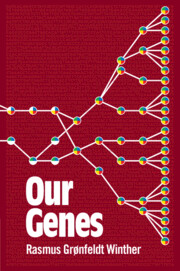Book contents
- Our Genes
- Frontispiece
- Our Genes
- Copyright page
- Dedication
- Contents
- Preface
- 1 Introduction
- 2 Origins and Histories
- 3 The Mind, the Lab, and the Field: Three Kinds of Populations
- 4 Metrics and Measures
- 5 Models and Methodologies
- 6 Six Patterns of Human Genomic Variation
- 7 Natural Selection
- 8 Intelligence, Female Orgasm, and Future Discovery
- 9 Is Race Real?
- 10 The Conscious Universe: Genes in Complex Systems
- References
- Index
- Plate Section (PDF Only)
5 - Models and Methodologies
Published online by Cambridge University Press: 14 December 2022
- Our Genes
- Frontispiece
- Our Genes
- Copyright page
- Dedication
- Contents
- Preface
- 1 Introduction
- 2 Origins and Histories
- 3 The Mind, the Lab, and the Field: Three Kinds of Populations
- 4 Metrics and Measures
- 5 Models and Methodologies
- 6 Six Patterns of Human Genomic Variation
- 7 Natural Selection
- 8 Intelligence, Female Orgasm, and Future Discovery
- 9 Is Race Real?
- 10 The Conscious Universe: Genes in Complex Systems
- References
- Index
- Plate Section (PDF Only)
Summary
Evolutionary genetics attempts to make evolutionary theory mathematically explicit through measuring change at the gene level, but once data have been gathered, modeling and interpretation – albeit contextual and thus limited – must be applied. In this chapter, I take a closer look at population modeling, moving from measurements and data to the investigation of two mathematical modeling strategies at the heart of genomic calibrations and analyses of human populations: variance partitioning and clustering analysis.
- Type
- Chapter
- Information
- Our GenesA Philosophical Perspective on Human Evolutionary Genomics, pp. 130 - 163Publisher: Cambridge University PressPrint publication year: 2022

